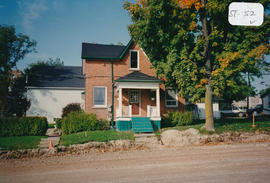The Dr. Clement House is located at 41 Simcoe Road (on the southeast corner of Simcoe Road and Centre Street). It was built around 1830-1860 (1840’s?) in the Classic Revival style. Dr. Clement lived and died here after practising in the 1870-80’s. He was buried in Clement Cemetery on the 2nd Line in Innisfil (east of Highway 11). His wife Rachel lived here until her death. The house was then rented to Walton, a railroad man for the C.N.R. The barn and garden behind the building ran to William St. (as did all the properties on the east side). Sam Catania and his wife Sarah lived here in later years. They converted the house into two apartments and had a dry cleaning business in the garage that was eventually destroyed by fire. Sam sold the house to Bruce and Barbara Verney. They were still living here when this photo was taken in 1995. Bruce was a chiropractor. A building used as a dry cleaner was constructed later on the property. Jack Pong (a restaurant owner on Holland St.) built a house on the back of this property that extended to Centre Street.
The street level has apparently been raised considerably around this house as the current 1½-storey, two-bay house was originally 2½ storeys. It has an asymmetrical façade and entrance, a simplified ‘temple’ form, and a medium-pitched, gable roof. The pediment roof shape has return eaves facing the front. A hip roof on the raised entrance portico is supported on wood beams with decorative, wood dentils. The corner columns have wooden ‘flutes’ and are mounted on brick pedestals. A wood-panelled door is flanked by narrow sidelights and is topped by a transom light. The house has small window openings with low floor to ceiling heights. Small, upper-floor windows are set into rectangular openings with plain, wood frames and sills. A ground-floor, bay window is an angled projection with a hip roof. The brick masonry foundation appears to be a replacement. A horizontal belt line at the top of the foundation is expressed with wood trim. The structure has wood frame construction with stucco cladding and a cut-stone foundation. Bricks found at the bay window foundation and at the entrance porch are probably not original. According to the 2000 inventory, the house is in good condition with many original details. (1, 2, 3, 4)
Dry Cleaning
2 Archival description results for Dry Cleaning
The mid-block building located at 52 Simcoe Road was built post-1900 (1902?) in the Gothic Revival Cottage style. The house, which is larger than other older cottages of a similar style in Bradford, was built on property owned by Charles Adams. Originally, there was a garden to the west and a barn on the lane. Later residents of this house included Joe Brown (a retired farmer from the 10th line) and Jessie, who lived here until he died. Joe was a noted gardener who raised his granddaughter Margaret Turner. Paul Margetiak and his wife and son also lived here at one time. He was a gardener, too, and he built a garage on the property. Len Saint did the cement work and added a closed-in porch. Eventually the property was bought by Gary Swagerman. He lived in the house with his wife and family and eventually had the barn remodelled to become the site of a dry cleaner. The garden was paved and used as a parking lot for the business.
The 1½-storey, three-bay cottage has a rectangular plan, a centre hall, and a symmetrical façade. The medium-pitched, gable roof has a centre gable over the entrance. There are single windows to the primary rooms on each side of the covered entrance porch. A raised, open porch has a hip roof supported on simple, wood columns set directly on the porch base/foundation. The porch has a simple, wood handrail and balusters. A single entrance door is set into a segmented, arched opening. Windows are set into segmented, arched openings with brick voussoirs and concrete lug sills. The windows and door are not original. A second-storey window set halfway into the centre gable is a reference to the Gothic Revival style. Locally-made bricks were placed by Tom Saint on the wood frame construction. According to the 2000 inventory, the house is in good condition. (1, 2, 3)

